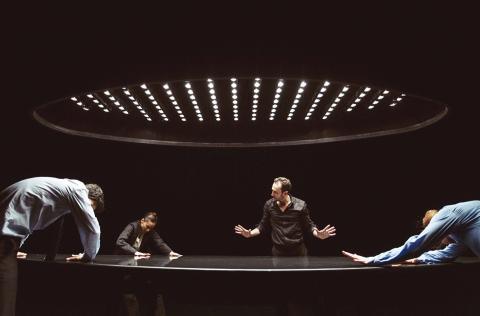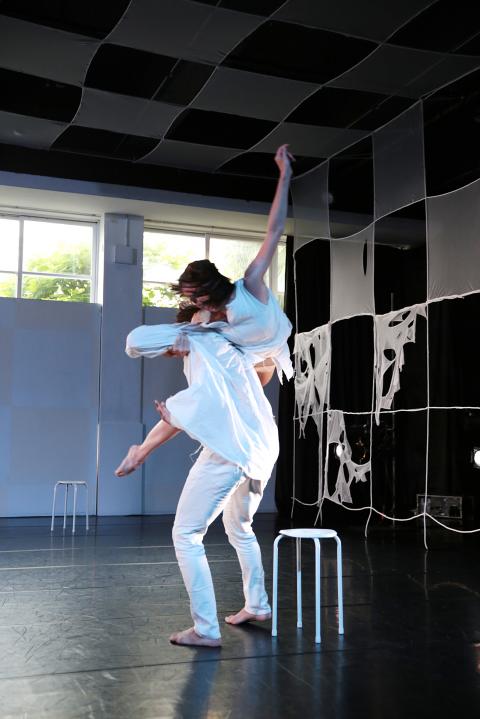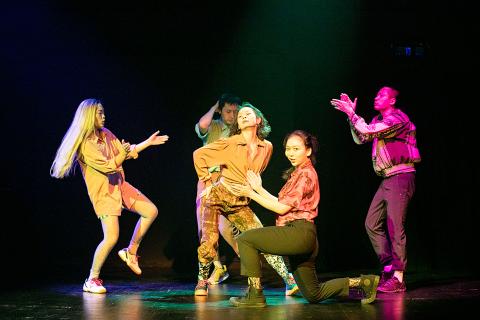There were a lot of ideas percolating about last weekend in Taiwan Made (台灣製造), choreographer Lin Juju’s (林祐如) contribution to the National Theater Concert Hall’s (NTCH) IDEAS Lab series. Most of them worked.
The IDEAS Lab, launched this year, combines what had been the three Innovation Series — theater, dance and music — into one format aimed at encouraging experimentation and collaborations.
Taiwan Made certainly fit the bill, as Lin decided to experiment by creating a piece through a collaborative process with five artists that she knew, although she had not collaborated with them before: dancer/choreographers Huang Huai-te (黃懷德) and Su Pin-wen (蘇品文), freelance dancer Wang Chu-hua (王筑樺), La Gitanita flamenco group founder Lee Lu (李律) and actor/Hao Hsiao Troupe (嚎哮排演) creative director Hsiao Tung-yi (蕭東意).

Photo courtesy of Rahi Rezvani
Lin wanted to explore what people mean and what they feel when they tell foreigners “I am from Taiwan;” what memories does that evoke, what cultural connotations?
Since all six were born in the 1980s, they used that as a starting point to explore Taiwanese identity from a personal perspective as well as a historical one.
The show was designed without seating, with scenes taking place at various spots in the black-box Experimental Theater, which meant the performers — Huang, Hsiao, Su, Wang and Lee — moved around and among the audience, sometimes interacting with them, and forcing audience members at times to choose who to follow, what to watch.

Photo courtesy of Century Contemporary Dance Company
Taiwan Made began with a dialogue between Huang and Hsiao, following a pattern familiar to anyone who has watched Taiwanese television variety shows, talking about childhood influences, including Michael Jackson. A later skit saw Lee recount trying to explain to immigration officials why a Taiwanese wanted to go to Spain and study flamenco.
While the audience began seated on the floor and lining the walls, with a few seated on part of a platform along one wall, everyone was forced to get up and move as the show progressed, making the theater look like a night market at one point, with crowds milling around different vendors; only these vendors were selling experiences, not food or clothing.
Taiwan Made ended with a silent-movie type skit, complete with a dog (stuffed) in a baby stroller, a police man, two births and some family drama, performed under five neon installations along one wall, by Zhou Xin (周欣).

Photo courtesy of Chou Jia-hui
At 70 minutes, the piece is Lin’s first full-length work, and a big departure for her. While I would have liked to see more dance, Taiwan Made proved an interesting experiment.
EXPLORING RELATIONSHIPS
Another thought-provoking piece was performed the previous weekend at Huashan 1914 Creative Park: Century Contemporary Dance Company (世紀當代舞團) presented Chen Wei-ning’s (陳維寧) The Present (禮物之靈).
Chen put her bachelor’s degree in psychology from Kaohsiung Medical University to work in the piece, which proved to be an often dark exploration of relationships and power dynamics.
It began with some zesty interplay between three couples before moving into scenes of domesticity and everyday life — brushing teeth, getting dressed — and then took a much more sinister turn.
Domestic violence and acts of domination — male on female and vice versa — with snapping fingers, physical manipulation and acts of degradation or slavish devotion came stood in sharp contrast to the playful beginning as well as the colorful, salsa-inspired finale.
Confined within the small, dark second-floor space, watching the dancers definitely made one think about the newspaper stories one reads of women and men trapped in abusive relationships for years, even decades, that go on behind closed doors.
I did find myself reflecting on several of the scenes as I raced down to Taichung after the show to catch the Nederlands Dans Theatre’s (NDT 1) first of two performances the National Taichung Theater that evening.
FOUR WORKS FROM HOLLAND
The NDT 1 dancers were in impeccable form as they opened their latest Taiwan tour with four complicated, challenging works that pleased the audience.
All four were internally produced and debuted in 2016, one by the house team of artistic director Paul Lightfoot and longtime creative partner Sol Leon, and the others by associate choreographers Crystal Pite, Marco Goecke, and Sharon Eyal and Gai Behar. However, only two of the pieces were truly memorable.
Hometown girl dancer Wu Meng-ke (吳孟珂) was not in the first piece on the program, Goecke’s Woke up Blind, but she earned thunderous cheers after her appearance in Pite’s The Statement as well as the other two works.
Goecke’s 15-minute piece, set on two women and five men to two jazzy songs by Jeff Buckley, was full of fidgety movements — hands and chests atwitter — interspersed with curvy articulations and arms and legs movements so sharp they could probably cut glass.
The choreography is certainly challenging for the dancers, but I failed to see any connection with the theme of young love in the high-intensity piece, which lacked any emotion.
However, that lack was remedied by the next work, The Statement, which proved to be a 19-minute riveting blend of satire, theater and dance that is a worthy inheritor of the mantle of Kurt Jooss’ landmark 1932 anti-war creation, The Green Table.
As American-accented voices read The Statement’s script — by Jonathon Young — two men and two women dance out the parts, their upper bodies often in conflict with what their legs are doing under the long oval table at center stage.
At issue is who is going to take the blame for some unspecified disaster in a conflict-ridden area, who knew what when — the “people up above” or those downstairs who were charged with instigating it — and what is going to be on the record.
The movements become more frantic as the pair from “upstairs” trade accusations with the other two: All four plot and bicker as they try to squirm their way out of the mess, moving around, under and on top of the table.
The Statement asks the question of our era: “What is the truth?”
While Wu was readily identifiable, the program, as it did for all four works, failed to give the names of rest of the cast, although it did credit Young and three other people for the “vocal performance.”
Eyal and Behar’s Bedroom Folk, set to a percussive score by Ori Lichtik, is a piece that requires uber-coordination and concentration, with the four men and four women moving as a group, though some occasionally slide in and out of formation.
With the driving score and repetitive, simplistic movements, the piece is hypnotic, and again demonstrates the highly toned technique of the dancers, but left me wondering “so what?”
However, the finale Lightfoot and Leon’s Shut Eye, was a very enjoyable and engaging exploration of moonlit dreams and fantasy worlds, with beautiful pairings and lifts. It left me wanting to see more of their work.

In the March 9 edition of the Taipei Times a piece by Ninon Godefroy ran with the headine “The quiet, gentle rhythm of Taiwan.” It started with the line “Taiwan is a small, humble place. There is no Eiffel Tower, no pyramids — no singular attraction that draws the world’s attention.” I laughed out loud at that. This was out of no disrespect for the author or the piece, which made some interesting analogies and good points about how both Din Tai Fung’s and Taiwan Semiconductor Manufacturing Co’s (TSMC, 台積電) meticulous attention to detail and quality are not quite up to

April 21 to April 27 Hsieh Er’s (謝娥) political fortunes were rising fast after she got out of jail and joined the Chinese Nationalist Party (KMT) in December 1945. Not only did she hold key positions in various committees, she was elected the only woman on the Taipei City Council and headed to Nanjing in 1946 as the sole Taiwanese female representative to the National Constituent Assembly. With the support of first lady Soong May-ling (宋美齡), she started the Taipei Women’s Association and Taiwan Provincial Women’s Association, where she

Chinese Nationalist Party (KMT) Chairman Eric Chu (朱立倫) hatched a bold plan to charge forward and seize the initiative when he held a protest in front of the Taipei City Prosecutors’ Office. Though risky, because illegal, its success would help tackle at least six problems facing both himself and the KMT. What he did not see coming was Taipei Mayor Chiang Wan-an (將萬安) tripping him up out of the gate. In spite of Chu being the most consequential and successful KMT chairman since the early 2010s — arguably saving the party from financial ruin and restoring its electoral viability —

It is one of the more remarkable facts of Taiwan history that it was never occupied or claimed by any of the numerous kingdoms of southern China — Han or otherwise — that lay just across the water from it. None of their brilliant ministers ever discovered that Taiwan was a “core interest” of the state whose annexation was “inevitable.” As Paul Kua notes in an excellent monograph laying out how the Portuguese gave Taiwan the name “Formosa,” the first Europeans to express an interest in occupying Taiwan were the Spanish. Tonio Andrade in his seminal work, How Taiwan Became Chinese,